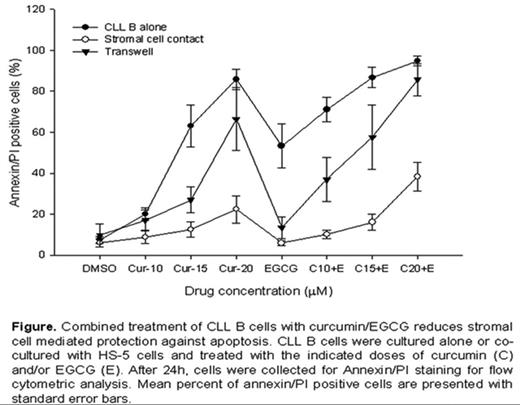Abstract
Background: B-cell chronic lymphocytic leukemia (CLL) is characterized by defects in the level of apoptosis rather than accelerated leukemic cell proliferation. We have been interested in identification of naturally occurring substances that induce apoptosis in CLL B cells with potential for therapeutic application with a favorable toxicity profile. Two such agents, epigallocatechin-3-gallate (EGCG) in green tea and curcumin from the spice turmeric have recently been studied by our laboratory. We have shown previously that in vitro treatment of CLL B cells with EGCG induces apoptosis [Blood, 2004, 104:788] and is now being tested in a Phase I/II clinical trial. In this study, we explored the possibility of using curcumin in the induction of CLL B cell apoptosis either alone or in combination with EGCG. We also tested their ability to induce CLL B cell apoptosis in the presence of human stromal cells.
Results: In vitro treatment of CLL B cells with curcumin induces apoptosis in a dose (5–20 μM) and time dependent manner. Further analysis suggested that curcumin treatment inhibited the effects of the constitutively active proteins STAT3, AKT and NF-κB and suppressed expression of XIAP in CLL B cells. Interestingly, we observed that curcumin/EGCG combination was more effective in the induction of apoptosis in CLL B cells as compared to the corresponding individual dose of the drug alone. We next evaluated the effects of curcumin when CLL B cells were co-cultured with the human stromal cell line HS-5. Curcumin-induced apoptosis was significantly inhibited when CLL B cells were co-cultured in physical contact with HS-5 cells. We also found protection against curcumin-induced cell death, albeit less, when CLL B cells were co-cultured with HS-5 separated by transwells. However, higher doses of curcumin can overcome HS-5 mediated apoptosis-protection of CLL B cells in transwells but, did not overcome the protective effect of physical contact with HS-5. Further analysis of CLL B cells co-cultured with HS-5 in transwells demonstrated elevated levels of STAT3 with increased phosphorylation at serine-727 and increased expression of Mcl-1 and XIAP. At this stage, we employed combined therapeutic approach to evaluate whether combining curcumin with EGCG could overcome stromal cell-mediated protection. Interestingly, combined treatment of CLL B cells could significantly overcome stromal cell-mediated protection against apoptotic cell death, although the effect was more pronounced when CLL B cells were separated by transwells (see figure below).
Conclusion: Together, these results suggest that curcumin induces apoptosis in CLL B cells in vitro and may mediate its effects by suppressing the constitutively active signaling pathways that are known to be important in apoptosis resistance This work also demonstrates that stromal cells and their soluble products can resist drug-induced apoptosis of leukemic CLL B cells. Importantly, the apoptosis-inducing activity of curcumin and EGCG is not impaired completely in the presence of stromal cells, suggesting that the combination of curcumin/EGCG may warrant clinical testing in patients with CLL.
Combined treatment of CLL B cells with curcumin/EGCG reduces stromal cell mediated protection against apoptosis. CLL B cells were cultured alone or co-cultured with HS-5 cells and treated with the indicated doses of curcumin (C) and/or EGCG (E). After 24h, cells were collected for Annexin/PI staining for flow cytometric analysis. Mean percent of annexin/PI positive cells are presented with standard error bars.
Combined treatment of CLL B cells with curcumin/EGCG reduces stromal cell mediated protection against apoptosis. CLL B cells were cultured alone or co-cultured with HS-5 cells and treated with the indicated doses of curcumin (C) and/or EGCG (E). After 24h, cells were collected for Annexin/PI staining for flow cytometric analysis. Mean percent of annexin/PI positive cells are presented with standard error bars.
Author notes
Disclosure:Consultancy: Celgene (NE Kay). Research Funding: Bayer (TD Shanafelt and NE Kay); Hospira (NE Kay).


